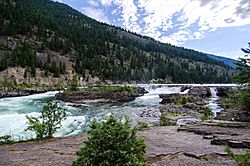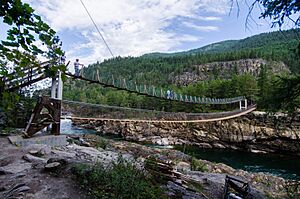Kootenai Falls facts for kids
Quick facts for kids Kootenai Falls |
|
|---|---|
 |
|
| Lua error in Module:Infobox_mapframe at line 185: attempt to index field 'wikibase' (a nil value). | |
| Location | Lincoln County, Montana United States |
| Coordinates | 48°27′20″N 115°45′48″W / 48.4555015°N 115.763198°W |
| Type | Plunge |
| Total height | 17 metres (56 ft) |
| Longest drop | 9 metres (30 ft) |
| Average width | 258 metres (846.5 ft) |
| Watercourse | Kootenay River |
| Average flow rate |
731 m3/s (25,820 cu ft/s) |
Kootenai Falls is a beautiful waterfall on the Kootenay River in Lincoln County, Montana. You can find it right off U.S. Route 2. It's the biggest waterfall in Montana that hasn't been dammed. It's also one of the largest waterfalls in the United States when you look at how much water flows through it. You can easily reach the falls by following a walking path from the parking area near the highway.
For the local Kootenai Tribe, these falls are a very special and sacred place. In recent years, Kootenai Falls has become a popular spot for visitors. This is partly because of the Kootenai Falls Swinging Bridge, which is just a short distance downstream. This bridge was first built in the 1930s to help firefighters. It has been rebuilt a couple of times, most recently in 2019, to make it safer for all the people who come to visit. You might have even seen the falls and the bridge in movies like The River Wild (1994) and The Revenant (2015).
The area around the falls is home to amazing wildlife, including large animals like bighorn sheep and American black bears. The rocks here are very old, made of sandstone and shale that have been folded and squeezed over millions of years. You can even see signs of ancient algae and water marks from a time when Montana was covered by water.
History of Kootenai Falls
The Kootenai Falls are a very important and sacred place for the local Kootenai Tribe. They believe the falls are the center of the world. It's a place where tribal members can connect with spiritual forces. These forces help guide the tribe and its people.
In the early 1800s, a Canadian explorer named David Thompson explored the Kootenay River area. He worked for the Northwest Company. Thompson used the Kootenay River as a guide, following paths made by Native Americans and animals. He had to carry his boat around the falls. He followed piles of stones, called cairns, that the Kootenai people had built. Then, he continued his journey up the river.
Kootenai Falls Swinging Bridge
The Kootenai Falls Swinging Bridge is a special swinging footbridge. Locals often just call it the Swinging Bridge. It crosses the Kootenay River just below Kootenai Falls. The bridge was first built during the Great Depression by the Civilian Conservation Corps. This group helped people find jobs during tough times.
The bridge helped the US Forest Service get firefighters to the forests north of the river. Today, anyone can walk across the bridge. It gives visitors amazing views of Kootenai Falls from above.
The first bridge was washed away by a flood in 1948. Soon after, a new bridge was built on strong concrete supports. These supports were made tall enough to be safe from future floods. The bridge was kept in good shape for many years. However, because more and more people wanted to visit, it was rebuilt again in 2019. The new bridge cost between $500,000 and $600,000. It was finished two months earlier than planned!
Geology and Wildlife
The Kootenai River Gorge is made of sandstone and thin layers of shale. These rocks have been squeezed and folded over millions of years. This happened between 50 and 100 million years ago. The rocks themselves were formed about 1.5 billion years ago. At that time, much of Montana was covered by water. You can still see ancient ripple marks in the canyon. You can also spot large stromatolites. These are the remains of old algae mats.
You might see bald eagles in the tall cottonwood trees nearby. The Wildlife Management Area close to the falls is home to many animals. These include bighorn sheep, American black bears, and moose. There are many other animal species too. The plants in the area are also very diverse. Most of the common cone-bearing trees found in the Northwest grow here.
Gallery





